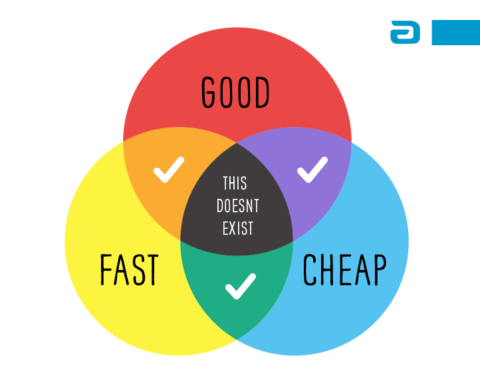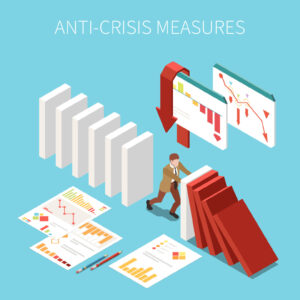As with any business process, there are risks in developing software, even in web and mobile development. Sometimes it can seem so overwhelming that you begin to wonder if it’s even worth the effort. Each risk, whether it relates to custom mobile or web development, can be backed up and managed.
If not eliminated, it can still be turned into a “positive risk” that brings value to your development process rather than having an opposite effect.
At Altamira, we have developed an extensive risk management in software development system applicable to different custom software projects. Here are some risks you may want to consider and the efficient solutions we can provide for your custom software development.
What is a risk management plan?
Having a risk management plan in place is a must for any type of custom software development. Of course, depending on the project’s requirements, some risks are uncertain, unexpected, and cannot be 100% predictable.
However, having a risk management strategy drives your decisions, minimises the potential risks and mitigates their harm to the development process. The risk management policy mostly depends on the company’s culture and customs of how it typically works on projects.
To say a few words about the benefits of really considering the potential threats and risks for your software project, at Altamira, we follow such steps:
Provide a secure IT environment for the software development team and the client as well
Ensure stable and transparent processes during development
Protect the development team from harmful actions that can lead to losing resources and money
As a client, you know what to expect at the end of the cooperation with the software development team

Risk #1: What do I want?
The most common risks in software development projects come from indecisiveness. The first thing you should do as a client is to understand what kind of custom business app you want to be developed.
The risk grows and the chances of the app becoming successful drop to a minimum if you don’t know your business goals and needs that will be fulfilled with the custom software solution.
You have to know what final results you want to see from the cooperation with your tech provider and what benefits it will introduce for your company.
Otherwise, you risk joining Google Wave.
Google Wave was launched in 2009 as an ambitious communication platform, but was developed and released without addressing user needs. Despite massive engineering investment, users found it confusing, which has led to the product being shut down in 18 months.
How to solve it
The risk of not knowing what you want is one that can easily be resolved. You can turn to Altamira to help you prepare the specifications and describe the whole idea of your application from scratch during the discovery stage.
Or you can try doing some homework before turning to our development company, and define the main requirements for the software before our first meeting. Utilising this small tip first will help you to answer and form the following ideas:
Define the main purpose that your app should serve.
Define 5 other business issues that your app should resolve.
Define the prospective target audience for your app.
Analyse your target audience: Decide if you want to target users of Android, iOS, web, or everything, if they are female or male, their age range, etc.
Find apps that are similar to your idea and determine if they are similar or identical to what you envision.
Look at the number of downloads your competitors receive to determine if their app is popular.
Take a look at your competitor’s reviews: search for what people want to change in their app and discover what they like or don’t like.
Define how your app will be different from existing competition to separate and distinguish yourself. Write down the features that your competitors already have and see what you can add to potentially improve the experience.
Write down the features that you would like to add.
How will you make money from it?
Will users pay for what you are going to sell?
By answering those questions, you will form a vision of your app and what profits it will bring to your business processes. And when answering all other questions posed by our development team, keep in mind those goals that you defined. Any decisions you make should be based on those business goals.
Risk #2: Technical specifications
Your idea needs to be put into technical wording in specification documents that would be clear to developers. Development without specifications is not a risk that our team takes, and we don’t recommend that anyone attempt it.
If you are working based on the “Time & Material” compensation model, you will spend lots of money on redoing what was already done previously. If you are working off a fixed price, it’s only a matter of time before you exceed your budget.
Technical specifications allow us to understand the scope of the whole project at once, bringing proper architecture of the solution. Nevertheless, these tech documents do not fully eliminate the need for changes during the development.
If you want to draw the wireframes yourself, it’s also a risk unless you have experience doing it because wireframes should be designed in a way that keeps the application both user-friendly and comfortable to use. Some tools that would be helpful for wireframing include:
Axure: This is the tool we use at Altamira for wireframing. With it, you can make an interactive prototype with its sharing option and numerous widgets.
Figma: Cloud-based design tool built for collaboration. It allows designers, developers, and stakeholders to co-edit and comment on wireframes and prototypes in real-time.
Balsamiq: This is a paid service that claims to give “rough” interfaces to encourage and provide lots of feedback.
Justinmind: This is a popular, paid solution for beginners.
Not understanding the technical risks of software development could lead to another Knight Capital disaster.
In 2012, Knight Capital lost $440 million in 45 minutes due to a software deployment error caused by a lack of proper documentation and testing procedures.
While this is from finance, the core issue was missing specifications and unclear implementation plans. This is why technical specs aren’t a formality, but critical safeguards against catastrophic misfires.
How to solve it
We would recommend that you turn to a team of professional app developers. In our company, the client is involved in this stage too, simply by working through each screen with us. We also have regular meetings where we provide suggestions and help the client come up with a final decision.
Risk #3: Resources/budget/deadlines
Have you gotten acquainted with the famous triangle depicted in the diagram below?

Considering this formula, you need to select the part of the triangle that would best align with your business goals:
If it’s a small prototype, it makes sense to aim for a “Cheap” and “Good” solution, and then invest more into the project once you’ve verified your idea with users.
If you just need a presentation for investors in order to tap into some financing, it makes sense to go for a solution that’s “Fast” and “Cheap”.
If you are looking for a high-quality application that will last you for a long time, you need to be patient and go with “Expensive” and “Good”, and definitely not fast.
Poor planning can lead to devastating results. Take the Denver Airport Baggage System, for example.
The airport’s automated baggage system infamously overran its budget by $560 million and was 16 months late. The main reasons were over-ambition, poor planning, and failure to align scope, time, and resources — the exact “project triangle” we mentioned.
How to solve it
When you get a quote from the development team, check it against this drawing and make sure that you critically review:
Your deadline
The budget you are willing to allocate
Diligent with the selection of which development team to hire.
How to address app development deadlines
Find out what timelines the development team is comfortable with and see if it’s better to agree to those timelines rather than what you had hoped, but get better quality results. Come to an agreement on the deadline together with the team, instead of pushing for tight deadlines that can have a negative impact on the solution’s quality.
How to address app development resources
To avoid this risk in software development, use the following resources when searching for your app dev team:
See the reviews of the team you plan on working with (Clutch is a reliable resource for it). Ask for references and a portfolio.
Get familiar with the domain and technical expertise your potential technical vendor offers, it shows if the development team is aware of the most relevant innovative technologies that need to be implemented for your custom business app development.
We are constantly working to extend the range of our service and be proficient in the latest tech trends to deliver top-notch software solutions for our clients and always meet their business needs to help them satisfy their business objectives.
Check if they provide a discovery stage (all top-notch companies like Altamira offer it). If they don’t, see Risk #2.
Ask them to tell you about their process of development by asking the following questions:
Will I have access to the code? It’s better if they do provide it so that if anything goes wrong, you have the code that you paid for.
Will they provide test apps and links? It’s better if they do so that you can track the progress.
Will you have a dedicated team? It’s better this way because developers won’t be distracted by other projects and will keep to the timelines they have promised.
How will the process of reporting and communications go? It’s better if they provide a dedicated project manager who will keep you up to date and communicate with you while the whole team is working.
Do you have experience developing similar apps? It’s better if they do, but a history of working with the features that you want in your app is good enough.
If you are satisfied with their answers, feel free to negotiate the quote. Remember that a reliable team with proven experience will usually cost more because they have a transparent cooperation process in place, like that of Altamira.
Turning to a freelancer or an unreliable company without references, reviews, or even a portfolio would carry risks because the company could disappear when it feels that it can’t meet the terms you agreed to.
How to address app development costs
Compare the timelines that you envisioned compared to the timeline that the developers foresee, as well as the number of features you got from the expenses. If the cost is not what you expected, it’s not the end and not a reason to start panicking.
You can still work with the budget. See our blog article on managing software development costs.
When you are reviewing the quote, make sure that the development team didn’t miss any functionality that both of you agreed to include in the app.
At Altamira, we are open to suggestions from our clients and ready to adjust to their timelines and budget in order to deliver high-grade custom software satisfying their business needs and requirements.
Risk #4: Changes are inevitable
Agile development is designed to embrace change, but when every new idea, feature request, or pivot is accepted without evaluation, the consequences stack up quickly.
Unmanaged change leads to cost creep, a slow accumulation of budget overruns due to added complexity, extended timelines, and rework. Teams may spend weeks developing features that weren’t in the original plan, creating misalignment between stakeholders and developers, or worse, building a bloated and unfocused product.
Agile only works when paired with disciplined backlog grooming and a clear process for evaluating the impact vs. urgency of each change.
A good example of why unmanaged change leads to cost overruns comes from the FBI Virtual Case File system (VCF).
The VCF was meant to modernise the FBI’s case management, but the project collapsed after $170 million was spent and the system was never deployed. Behind the failure, just one reason: constant, unmanaged changes in scope and expectations from leadership. Agile wasn’t the issue — lack of change discipline was.
How to solve it
Assess the number of changes you are burdening the team with, including the following:
Do you evaluate those changes against business goals before their approval?
Assess how important they are on the scale of 1-10, where 10 ranks an issue as being extremely important. If they rank more than 7 points, make sure to request an estimate of how much the change will cost.
Make sure that the team estimates the changes and lets you know how the change affects the architecture of the app. Assess if the app needs it now on the same scale of 1-10 when you know how much the change would cost and how much effort it would take.
If they rank more than 7 points, plan to roll out this change for the next development milestone or release.
Risk #5: Communication with the team
One of the biggest risks of outsourcing software development is when the decision-maker is unavailable/cannot be reached. This is especially true for clients who are busy with their regular business and are ordering the application as their second option for revenue.
Altamira team takes the major part of the work and is always ready to make recommendations, but if there’s no person to make a decision, answer questions, make a payment, review the ready part, etc.; the risk of the app becoming something they didn’t intend it to be is very high.
Therefore, communication is one of the main offshore software development risks to be accounted for. At the stage of specifications, the application’s development would take 50% of your time. The more time you allocate to it, the quicker and more productive this stage will be.
Once the stage is over, we will need less of your attention. The release stage is another heavy stage that requires your involvement, since it will include lots of preparations, legal documentation, purchasing of services, etc.
To understand how important communication is, remember Healthcare.gov.
When Healthcare.gov launched in 2013, it was riddled with issues. One of the root causes was fragmented communication among dozens of contractors and the absence of a single, accountable product owner to make timely decisions.
How to solve it
In relation to the risk of not being available or having a lack of communication on the app development, follow these suggestions:
Make sure you indicate the time when you are free for meetings with the project manager or the team.
Make sure you check emails regularly and provide answers to the team in time.
If you are not available or are going on a business trip, please provide a person of contact who can make decisions while you are away.

We also provided you with the Altamira project risk template, which you can check out by entering your email in the form below.
Managing risks at Altamira: use case overview
Software development risk assessment should become a satellite of your project from the idea inception stage to the maintenance phase and onwards.
Ignoring this procedure will sooner or later lead to issues with the budget, an increase in the cost of the features’ development, changes in delivery dates, limitations in development due to architectural limitations, or even more, it could turn into a blocker that would kill the whole project.
Can you imagine a project that is about to be released but can only be released with proper risk management built in from the initiation stage? This is what the reality is today.
That was exactly the case we were dealing with in one of our projects at Altamira.
We were working on an IoT project for an American company. In order to be able to perform development and testing, we required access to the physical devices that they used. A device was sent to us, but it was only one set of sensors; those sensors were only prototypes, and not only that, this was at a time of strict COVID-19 lockdowns when everyone could have had to work remotely.
The very first thing we did as a team was the preparation of the risk profile. We brainstormed in the following directions:
How to perform development and testing with minimal-to-no gaps when everybody needs this set of sensors to get work done?
How to share the sensors between team members during the work-from-home era?
What if one of the sensors breaks?
What if the second pair of sensors is mailed out and there are delays in the mailing system delivery during unprecedented times of the COVID-19 pandemic?
What should we do if the issue is not in the code but in the sensors themselves?
These are only a couple of concerns we raised during that meeting. Our next step was to sort out all the risks and come to an understanding of how to mitigate them.
Once the document was ready, we scheduled a call with our stakeholders to go through the risk register and discuss literally every point. This conversation helped us discover even more potential issues and to agree on the immediate actions to take that helped us mitigate or negate the damages/losses if the risk does come to its head.
Last but not least, we came to one (common) vision on the project budget and what would influence it, as well as regarding its limitations and timelines, taking into account those risks and mitigation plans.
Our goal was not to prepare a list of ‘disclaimers’ (and to forget about it until a disaster takes hold) but to build up a list of contingency plans “B, C, D, …” to deliver the project in the shortest possible period of time and within the budget constraint.
Therefore, we were constantly going back to that document with the team and stakeholders, discussing and updating it as needed.
In the end, we faced limitations of lockdown, issues with sensors, delays in delivery of the new pairs of [replacement] sensors, difficulties with planning out work when both developers and QA engineers required sensors at the same time, and many other issues.
A question, ‘Can we finish this project?’ could have been raised at literally any stage during the development cycle, the project could have turned into losses and never met customers.
But the fact that the risk management processes were in place, supporting the project every day and at every stage, the project was delivered successfully, with no gaps in the development process, providing the agreed-upon scope of functionality, while also satisfying the given budget constraints.
Due to our close cooperation with our clients, rather than solving issues, we deal with the risks, being proactive instead of reactive.
It’s always better to spend some time and money on outsourcing software development risks management on a regular basis than to deal with seemingly unmanageable issues when it could already be too late or too unprofitable.

In conclusion
Custom software development is a complicated process with plenty of details to take into account, like the needs and requirements of our client’s company, based on things like the industry they operate in, as well as the market position and uniqueness of the particular business. Custom app development risk management is tasked with making this process as smooth and predictable as possible.
The risk management plan actually shows developers what to do and what is better to avoid. That being said, managing these risks does require some spending; this money is definitely worth investing in order to successfully build and implement your software solution that will meet your expectations and requirements.
We are ready to build a risk management strategy for your custom app development in order to then deliver a highly functional solution that will greatly benefit your business for years to come, especially if you choose to regularly update your software to take advantage of any newly available improvements.
FAQ
The most widespread mobile app risks are related to overshooting budgets and being overly focused on project deadlines to the point where it hurts performance and quality. The range of risk is pretty large. However, experienced software development teams are able to devise appropriate risk management strategies for your particular project and keep the risk spectrum and probability of occurrence to a minimum.
Risks in app development require quick reactions, flexibility, and urgent actions. With the help of the Scrum methodology that we deploy here at Altamira, we are ready to adjust to any unexpected changes or deviations that we might encounter during development, even the completely unpredictable ones. We will surely devise a risk management plan before development starts in order to be ready for any potential threats and find ways of quashing them. You can also check out the risk tables that our specialists fill out for each project in the article.
Start by validating the core functionality—what does your app need to actually do? Then, break it down: Are there existing APIs or technologies that can support this? Has something similar been built before? A technical feasibility assessment (often part of the discovery phase) will help uncover blockers, hidden costs, or dead ends before you’ve spent a dollar on development.
Think of it as the part where you figure out what you’re building before you start building it. The discovery phase helps you clarify the problem, map out the solution, prioritise features, and spot risks early. It saves time, reduces waste, and gives your dev team something solid to work from, not just a vague idea and a deadline.
First, expect it—it happens. The key is to have a clear scope documented from the start and a simple way to evaluate new ideas. When someone wants to add a feature mid-build, pause and ask: does this solve the original problem, or is it a “nice to have”? If it’s valuable, adjust the timeline or budget accordingly. If not, log it for later. Boundaries now avoid chaos later.






